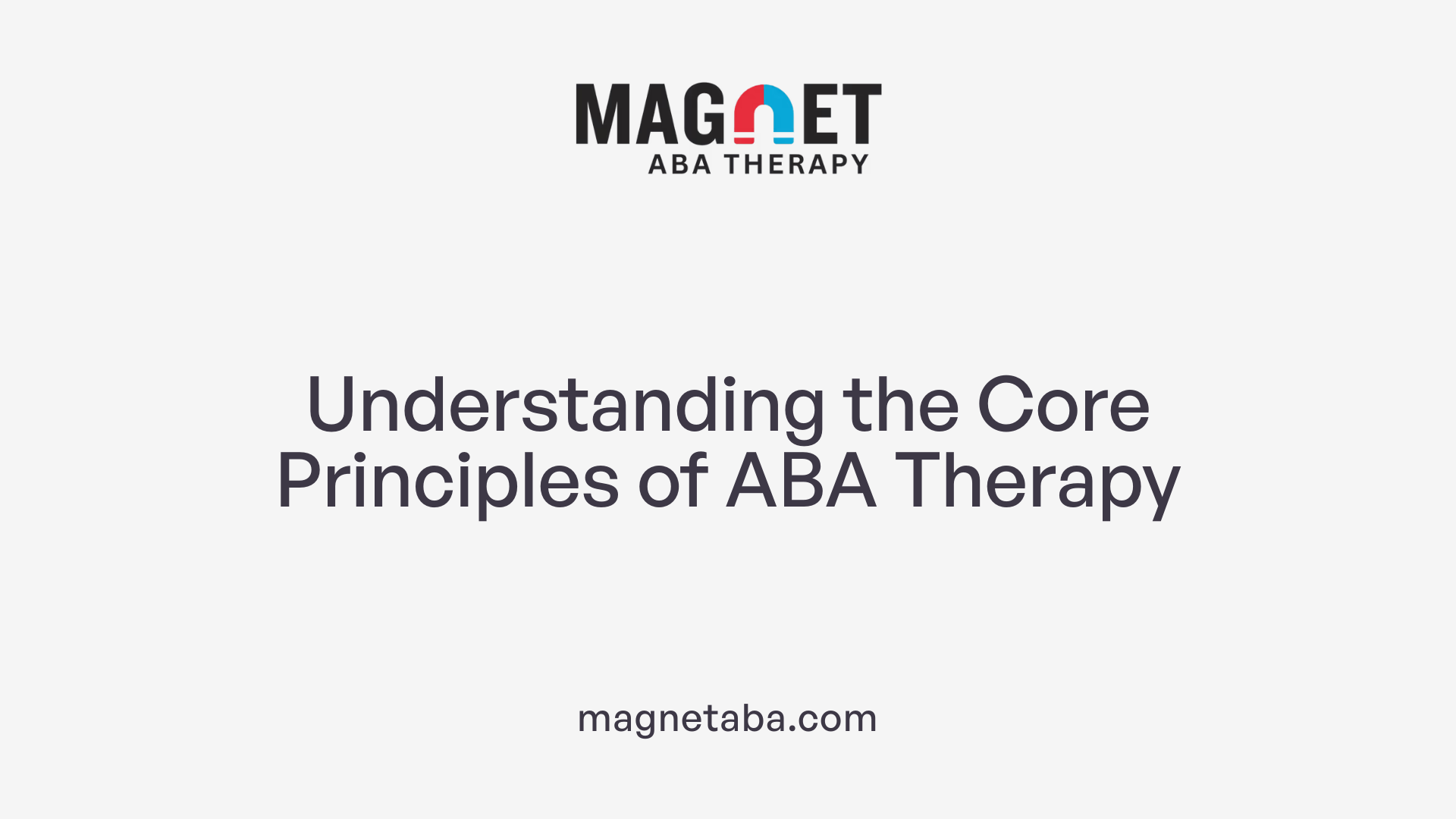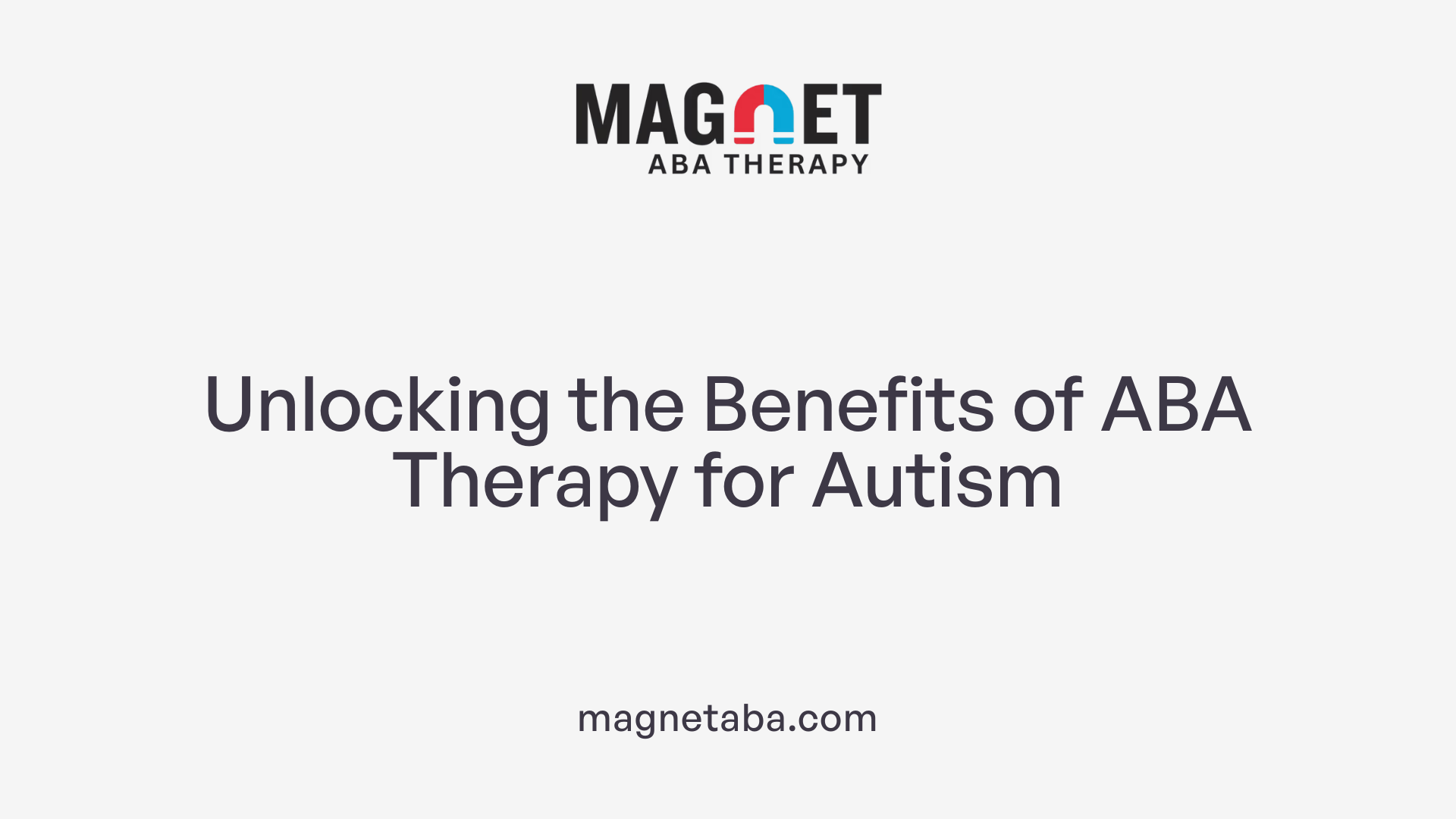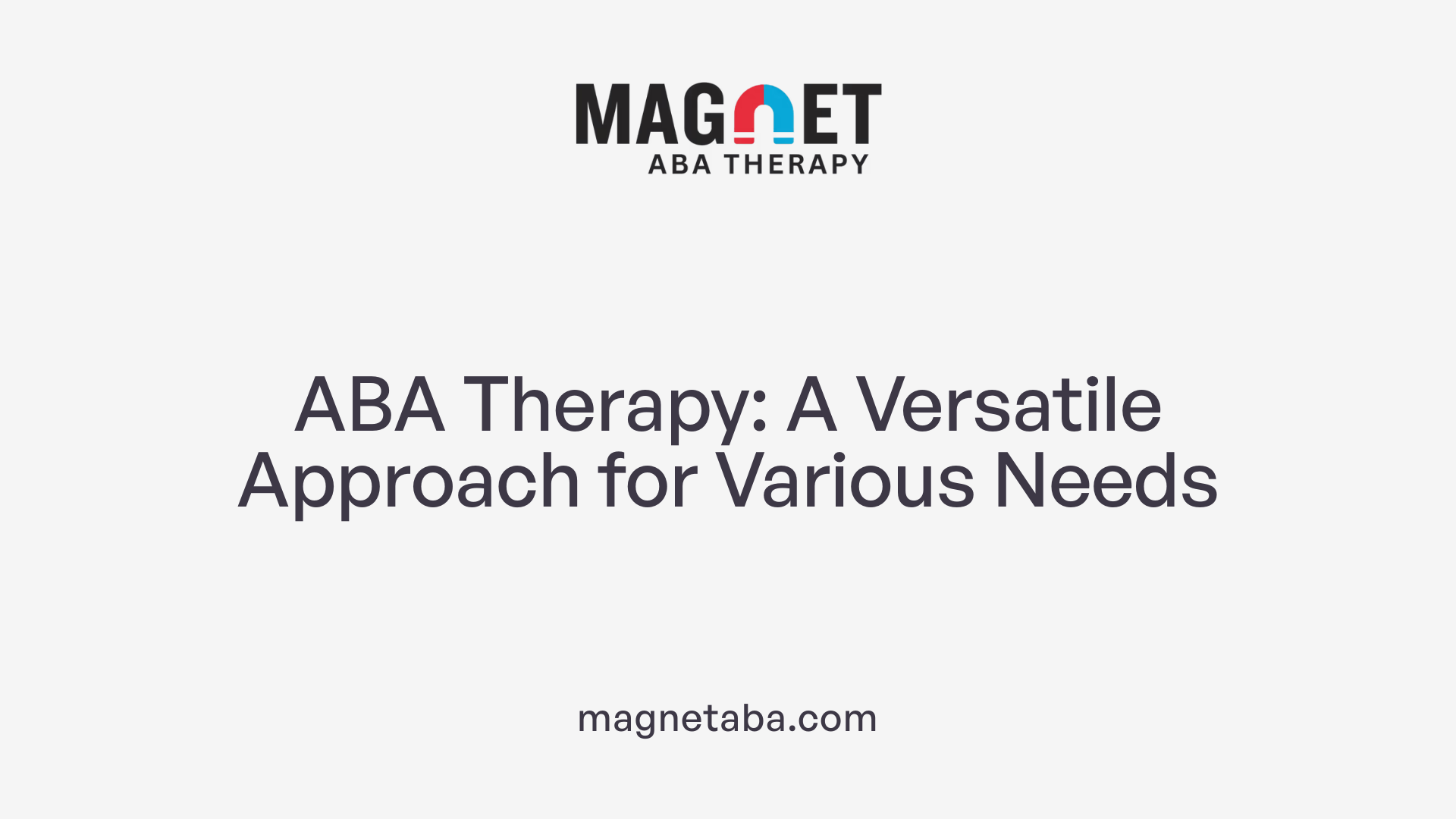Understanding ABA Therapy and Its Importance
Applied Behavior Analysis (ABA) therapy is widely recognized as an effective treatment for children with autism and other behavioral disorders. By focusing on enhancing communication, social interaction, and adaptive skills, ABA therapy plays a crucial role in a child's development. This article delves into the benefits of ABA therapy, addressing common questions and misconceptions while highlighting how it supports children's growth and independence.
The Fundamentals of Applied Behavior Analysis

What is Applied Behavior Analysis (ABA)?
Applied Behavior Analysis (ABA) is a research-based therapeutic approach primarily used to help individuals with autism and other developmental disorders by applying learning principles to encourage positive behaviors and reduce harmful ones. It focuses on enhancing skills in areas such as communication, social interaction, and self-care through individualized treatment plans.
ABA employs techniques like Discrete Trial Training, modeling, and positive reinforcement to promote learning and behavior modification. Each program is specifically tailored and supervised by Board-Certified Behavior Analysts (BCBAs), ensuring that interventions are suited to the unique needs of every child. This evidence-based practice is supported by rigorous scientific evaluation and is known to yield significant improvements, especially when implemented intensively during early childhood.
History and principles of ABA
The principles of ABA have been utilized since the 1960s, making it a time-tested method for addressing developmental challenges. At its core, ABA emphasizes understanding behavior in terms of environmental influences, utilizing the A-B-C model: Antecedent, Behavior, and Consequence. This framework helps modify behavior effectively by establishing links between actions and their outcomes.
Key principles also include:
- Positive Reinforcement: Rewarding desired behaviors encourages their recurrence.
- Individualization: Programs are customized based on thorough assessments, aligning goals with each child’s strengths and preferences.
- Skill Development: ABA aims to build essential skills such as communication, social interaction, and self-care to promote independence.
Through these principles, ABA therapy strives to improve overall functioning and quality of life for children with autism and related disorders.
Techniques and Strategies in ABA Therapy

What are some common ABA therapy techniques?
ABA therapy incorporates a variety of techniques that are designed to modify behavior, enhance learning, and promote independence in children. One prominent approach is positive reinforcement, where exhibiting desirable behaviors are rewarded to encourage repetition. In contrast, negative reinforcement focuses on removing aversive stimuli, fostering a positive learning environment.
Other fundamental strategies include prompting and fading, which involve providing specific cues or hints to assist children in mastering new skills, gradually reducing assistance to encourage autonomy.
Examples of techniques used in therapy sessions
ABA utilizes diverse methodologies suitable for different learning contexts. Here are some key techniques employed in therapy sessions:
- Discrete Trial Training (DTT): Breaking down skills into manageable steps, DTT is effective in reinforcing learning one component at a time.
- Natural Environment Training (NET): This technique aims to teach skills in real-world settings, enhancing the likelihood of generalization and application of learned behaviors outside the therapy room.
- Video Modeling: This approach demonstrates behaviors visually, allowing children to understand and imitate actions effectively.
- Behavior Contracts: These are often used with older children to clarify expectations and outline responsibilities in a written format.
- Functional Communication Training: This technique is essential for teaching alternative communication methods, allowing children to express needs without resorting to maladaptive behaviors.
These strategies are customized to align with each child's unique needs and goals, fostering skill acquisition and promoting well-rounded development.
Addressing Behavioral Challenges with ABA

Does ABA therapy help with behavior problems?
Yes, ABA therapy can help with behavior problems. It offers a structured, evidence-based approach that aims to modify behaviors and promote adaptive skills, especially in children with autism. Originally developed by O. Ivar Lovaas, ABA has evolved from controversial methods to focus primarily on positive reinforcement techniques that enhance communication and self-regulation.
With advancements in research, current ABA practices emphasize ethical treatment, inclusivity, and respect for cultural diversity. Overall, ABA therapy has shown effectiveness in improving behavior and teaching essential skills while being mindful of the individual needs of each person.
Are there misconceptions about ABA therapy?
Yes, there are several misconceptions about ABA therapy. Many people believe that it is rigid and only suitable for individuals with autism, but it is actually a flexible and evidence-based approach that can benefit a wide range of behavioral challenges, including ADHD and PTSD.
Another common myth is that ABA turns children into "robots" or focuses solely on punishment. Effective ABA promotes skill development, independence, and positive reinforcement rather than punitive measures. Additionally, ABA therapy is tailored to the unique needs of each individual and can be integrated into everyday life, rather than being confined to one-on-one sessions or specific settings.
Additional Insights on ABA Therapy
Through tailored interventions, ABA not only reduces problematic behaviors such as tantrums but also improves overall communication and social skills. Many families report transformative impacts by incorporating ABA techniques at home, helping children navigate daily challenges and integrate more fully into their environments.
By addressing these misconceptions, families can approach ABA therapy with a clearer understanding of its purpose and benefits, thus empowering their child towards a brighter future.
ABA Therapy: Unmatched Benefits for Autism

What are the benefits of ABA therapy for autism?
ABA therapy offers numerous benefits for individuals with autism, particularly in developing essential life skills. Key advantages include:
- Enhanced Communication and Social Skills: Children learn to express their needs effectively, improving interactions with peers and adults.
- Improved Attention and Focus: Tailored ABA programs help children concentrate better, aiding their engagement in activities.
- Academic Performance: By breaking down complex academic tasks into manageable steps, children often achieve better outcomes in school.
- Reduction of Problematic Behaviors: Positive reinforcement techniques encourage beneficial behaviors while decreasing harmful ones.
- Flexibility of Implementation: ABA therapy can be adapted for various environments—including home and school—ensuring consistent and effective support.
Is there evidence supporting ABA?
Numerous studies demonstrate the efficacy of ABA therapy. It has been recognized as an evidence-based practice by reputable organizations, endorsing its rigorous scientific backing.
Research indicates that intensive, long-term interventions (averaging 25 to 40 hours per week) result in substantial improvements in language development, social skills, and independence.
What are the long-term outcomes?
Long-term outcomes of ABA therapy can be transformative. Many children demonstrate significant progress in adaptive functioning, allowing them to reintegrate into mainstream educational settings successfully. Early intervention with ABA sets a foundation for lifelong skills, enhancing quality of life and social participation. The therapy's focus on teaching crucial life skills empowers children to manage their behaviors and navigate social situations effectively, paving the way for future independence.
Beyond Autism: The Versatility of ABA Therapy

Is ABA therapy only used for autism?
ABA therapy is not exclusively used for autism; its reach extends far beyond this well-known application. Originally tailored for children with autism spectrum disorders, ABA has been effectively utilized to address a variety of behavioral and cognitive issues in both children and adults. Conditions such as ADHD, OCD, and PTSD benefit significantly from ABA techniques, showcasing the therapy's versatility.
How is ABA therapy adaptable?
The adaptability of ABA therapy plays a crucial role in its effectiveness. Each therapy plan is personalized, addressing the specific needs and goals of the individual. By utilizing positive reinforcement and breaking down tasks into manageable steps, ABA caters to diverse learning styles and environments. This adaptability ensures that the therapy can be applied across various settings—from home to schools to clinical environments—making it a valuable approach for a wide range of learners. Furthermore, its methods have evolved to focus on enhancing learning experiences, proving that it is a comprehensive treatment capable of addressing numerous challenges beyond the scope of autism.
The Parent's Perspective: Choosing ABA
Why do parents choose ABA-based interventions for their child?
Parents often select ABA therapy for their children because of its strong scientific backing, demonstrating its effectiveness in enhancing behaviors, communication, and social interactions. Many regard ABA as the "gold standard" for autism treatment, thanks to its structured methods and positive reinforcement techniques that facilitate learning in diverse environments.
The role of parental involvement
Parental involvement is critical in ABA therapy. This approach empowers parents with practical strategies to manage behaviors and reinforce new skills outside of therapy sessions. Research shows that when parents actively participate, it boosts their child's progress towards therapeutic goals and helps reduce stress within the family.
Impact on family dynamics
The influence of ABA therapy extends beyond the child; it significantly enhances family dynamics. As parents acquire skills to support their child effectively, their confidence grows, strengthening the parent-child relationship. Ultimately, ABA not only supports children’s growth but also fosters a more cohesive and understanding family environment.
Supporting Communication and Independence through Customization
Customized ABA Therapy Plans
ABA therapy is highly customizable, which is essential for addressing the diverse needs of children. Individualized treatment plans start with a thorough assessment of each child's unique skills and communication abilities. Techniques like augmentative and alternative communication (AAC), including Picture Exchange Communication Systems (PECS) and speech-generating devices (SGDs), can enhance a child's ability to express needs effectively.
These tailored therapy sessions ensure that each child's learning style is recognized, allowing them to progress at their own pace. As they learn to communicate better, children also develop social skills necessary for peer interactions and forming relationships.
How is ABA therapy customized to benefit communication skills and independence?
ABA therapy benefits communication skills and independence primarily through bespoke treatment plans. These plans assess a child's particular needs and employ evidence-based techniques including positive reinforcement, prompting, and visual supports. By reinforcing successful communication attempts, children are motivated to engage more in social settings.
Gradually reducing support through prompting and fading teaches children to navigate interactions independently. Overall, this structured approach not only builds essential communication skills but also fosters personal growth and self-reliance, equipping children with skills necessary for greater independence in everyday life.
A Transformative Approach for Children's Development
ABA therapy stands as a transformative approach for children facing behavioral disorders, notably autism. With its focus on tailored, evidence-based interventions, ABA has demonstrated significant success in improving a range of skills essential for personal and social development. By involving parents and caregivers in the therapeutic process, the therapy not only enhances the child’s abilities but also enriches family dynamics. As research continues to validate its effectiveness, ABA therapy remains a cornerstone of developmental support, paving the way for children to achieve greater independence and integration into society.
References
- Applied Behavior Analysis (ABA) | Autism Speaks
- 6 Life-Changing Benefits of ABA Therapy for Children with Autism
- The Top 10 Reasons Children With Autism Deserve ABA - PMC
- Applied Behavior Analysis (ABA) - Cleveland Clinic
- Top 10 Benefits of ABA Therapy | Blossom Children's Center
- Benefits of ABA Therapy for Children with Autism
- 5 Benefits Of ABA Therapy For Autism - Surpass Behavioral Health
- Applied Behavior Analysis: What Is It and How Does It Work? - WebMD
- Benefits of Applied Behavior Analysis (ABA) Therapy for Children












